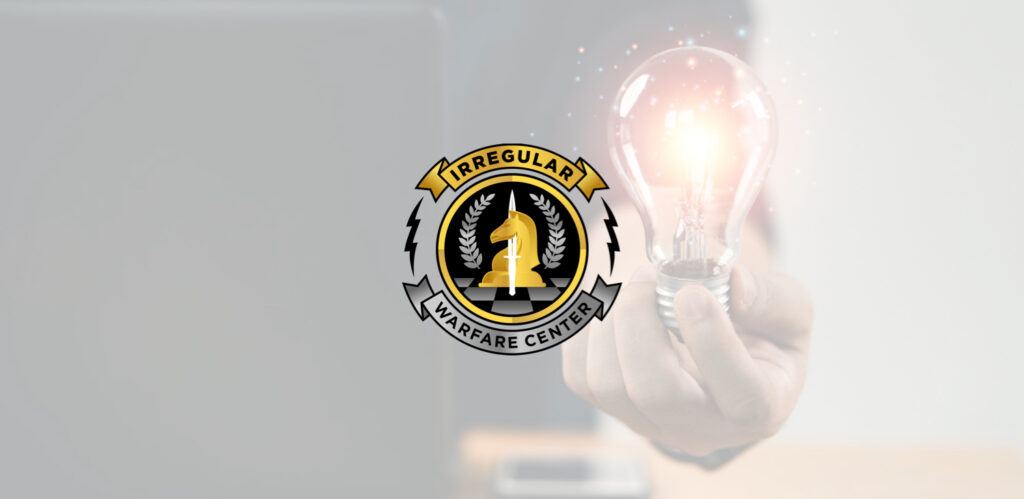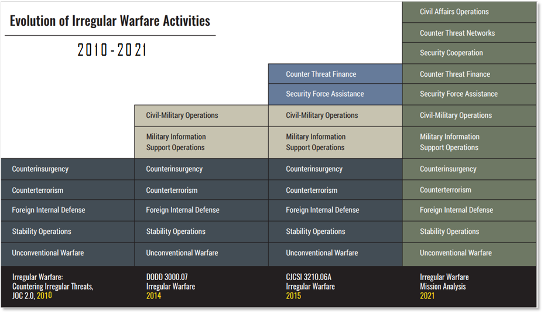
Reframing the Term “Irregular Warfare” in Times of Peace into the Contemporary Idea of “Defense Support to Strategic Competition”
LTC Timothy J. Murphy – Special Operations Center of Excellence – U.S. Army Irregular Warfare Proponent Director, USAJFKSWCS
Dr. Jeffrey V. Gardner – Irregular Warfare Center – Chief of Faculty and Curriculum
Brittany Carroll – Irregular Warfare Center – Senior Military Analyst (Valens Global Contractor)
In contemporary global security dynamics, the terminology used to describe military and strategic operations is crucial. The terms “irregular” and “warfare” often either fail to resonate with foreign partners and U.S. government interagency partners or raise red flags due to different organizational meanings, as they imply a state of conflict that is not necessarily present. This publication explores the shift from traditional concepts of Irregular Warfare (IW) to a more fitting term, “Defense Support to Strategic Competition,” to describe the Department of Defense’s (DoD) activities short of war in support of interagency organizations and foreign partners. Ultimately, various components within the DoD are capable of providing valuable assistance and support to interagency organizations to create enduring advantages in Strategic Competition. However, a barrier exists in understanding among organizations as to what “irregular warfare” is and how it can be applied in Competition and Crisis prior to an overt military conflict.
For several years, the DoD has had significant challenges selecting the appropriate language that meaningfully conveys its efforts to support a whole-of-government approach to Strategic Competition. In times of relative peace, the DoD can and must utilize its resources to support the Department of State (DoS) and other agencies with activities that are specifically designed to both maintain strategic advantages below the threshold of widespread conflict and prepare an area for U.S. advantage should a conflict erupt. In these times of peace, the DoS typically serves as the lead agency for these activities. The paradox: it is not domestically or internationally appropriate for democracies to execute any kind of “warfare” when those democracies are not technically at war.
Short of war, many modern-day complexities and challenges emphasize the need for non-traditional, irregular, and unconventional approaches to both counter and compete with Strategic Competitors. IW, including its 12 Operations and Activities, fits hand-in-hand with confronting these challenges, though the term “irregular warfare” is insufficient in conveying these efforts when not in a shooting war or Large-Scale Combat Operations (LSCO).[1] This publication examines the problematic nature of using the term “irregular warfare” as it pertains to DoD activities designed to support whole-of-government and allied and partnered efforts in Strategic Competition. The fact is, Western democracies, including the United States, are reticent to act as though they are in a perpetual state of war. Instead, democracies attempt to keep a high level of transparency while competing with adversaries and cooperating with allies and partners. Only when absolutely necessary do democracies enter into a state of war with an enemy. Therefore, the DoD should relook its IW definition when its operations and activities are being executed during times of peace. This article proposes a more appropriate term for irregular activities when the U.S. is not at war. Further, the name for these irregular activities should reflect the nature of DoD’s supporting role to other agencies, like the DoS, in these “short-of-war” situations. To this end, we should rename DoD’s peacetime irregular activities as Defense Support to Strategic Competition (DSSC). There is DoD precedence for this type of cooperation, as this would be the overseas analogy to how the military provides assistance within the homeland during Defense Support to Civil Authorities (DSCA) missions.

The Challenges of “Irregular” and “Warfare”
The word “irregular” suggests actions that deviate from the norm, which can be confusing or misleading for international partners who may not share the same terminology or references that are historical or cultural in nature. Moreover, “warfare” inherently implies a state of conflict, which is inappropriate when discussing peacetime activities with U.S. interagency partners like the DoS, USAID, or other interagency organizations. Despite these nuances, many interagency organizations recognize the security challenges posed by Strategic Competition, which lends well to the assistance that DoD can provide.[2] These partners operate under the assumption that they are not “at war,” which complicates collaboration if the language used implies otherwise. Simply put, the DoD maintains different and flexible definitions of irregular warfare that are not necessarily shared by its partners and parallel organizations. Short of war, DoD has the ability to use “irregular” activities and tasks to both support and enhance interagency and partner organizations, without traditional war as a primer to conduct said activities. The DoS publicly recognized some current complexities in a December 2023 remarks publication that potentially illuminate avenues for the DoD and/or foreign partner assistance, addressing irregular and non-traditional challenges posed by China and Russia.[3] In a way, these activities would be the Strategic Competition lens of support similar to those of Defense Support to Civil Authorities. The complexities of modern-day challenges pose the need to evolve the definition of irregular warfare to more effectively work with interagency and foreign organizations. At the same time, providing this posed view of “Defense Support to Strategic Competition” could quell concerns among interagency and foreign partners that arise when hearing “irregular warfare” during peacetime. The addition of the word “support” within Defense Support to Strategic Competition also highlights the point that the DoD is not trying to walk into the DoS or any County Team and take over or take charge. During times of peace, the DoD’s role is to make a supporting contribution to Strategic Competition.
The Evolution of Irregular Warfare Concepts
The concept of IW has evolved significantly over time and has been influenced by changes in geopolitical landscapes and strategic priorities. Historically, IW was synonymous with activities like counterterrorism and counterinsurgency, especially during the Global War on Terror (GWOT). The 2007 IW Joint Operating Concept defined IW as a struggle among state and non-state actors to influence populations and affect legitimacy, favoring indirect and asymmetric approaches to erode an adversary’s power.[4]
However, as the U.S. strategic focus shifted from GWOT to Strategic Competition with major powers like China and Russia, the definition of IW also needed to adapt. The traditional focus on counterterrorism and counterinsurgency became less relevant, though not diminished, and the broader scope of Strategic Competition required a new conceptual framework. In recent years, the DoD and a wide range of interagency and foreign partners have publicly recognized the need to address contemporary complexities in a new and joint way. In 2023, the U.S. Joint Chiefs of Staff posed an idea and issued a strategy titled “Joint Concept for Competition,” which recognizes the need for integrated campaigning, cooperation, and integration to tackle Strategic Competition.[5] This approach fits the mold of “Defense Support to Strategic Competition” by implementing a joint approach to conduct irregular activities during all forms of Strategic Competition, including short-of-war or “left of bang.” It also includes and encourages the inclusion of foreign partners and organizations across various geographic regions, which have varying perceptions and definitions of irregular warfare and activities.
Regional Conceptualizations of IW
Different regions conceptualize IW based on their unique historical and geopolitical contexts. In the Indo-Pacific region, IW is often viewed through the lens of domestic legitimacy struggles between state and non-state actors, heavily influenced by counterterrorism, counterinsurgency, and other considerations. This mirrors the earlier U.S. definition during GWOT but no longer applies in the context of Strategic Competition. In some Asian nations the term asymmetric can work, but irregular just does not translate well.[6]
In contrast, European perspectives on IW have been shaped by hybrid and gray zone threats, particularly from Russia. The concept of hybrid warfare, sometimes referred to as irregular warfare or asymmetric warfare, encompasses a range of activities below the threshold of conventional warfare or that occur in sync with conventional warfare, including cyberattacks, disinformation, and political subversion.[7] This broader view reflects the diverse threats faced by European nations and the United States, emphasizing the need for a more flexible approach to security. Many of these instances occur prior to actual war or other forms of conflict, but these instances can be addressed through the idea of Defense Support to Strategic Competition.
The New U.S. Army and Joint Definitions
The U.S. Army’s 2022 Field Manual (FM) 3-0 redefined IW as the employment of military and non-military capabilities across multiple domains through methods other than military domination of an adversary.[8] Verbatim, the definition states IW is “the overt, clandestine, and covert employment of military and non-military capabilities across multiple domains by state and non-state actors through methods other than military domination of an adversary, either as the primary approach or in concert with conventional warfare.”[9] This definition acknowledges the importance of both traditional and irregular approaches in addressing modern security challenges.
Similarly, the Joint Staff’s 2023 definition in Joint Publication 1 (JP-1) describes IW as a form of warfare where states and non-state actors campaign to assure or coerce others through indirect, non-attributable, or asymmetric activities.[10] This definition emphasizes the integration of IW with conventional warfare and the need for a comprehensive approach to security.
Regardless of definition, it is extremely unlikely and uncommon that the definition of irregular warfare is the same among organizations. By annotating each definition, we can more accurately frame the objective of these efforts into “Defense Support to Strategic Competition” to encompass the short-of-war or pre-conflict activities and efforts.
Congressional Definition and Its Implications
The 2024 National Defense Authorization Act (NDAA) introduced a new definition of IW, highlighting activities not involving armed conflict that support U.S. policy and military objectives.[11] Verbatim, the 2023 Congressional definition of IW states that IW means “Department of Defense activities not involving armed conflict that support predetermined United States policy and military objectives conducted by, with, and through regular forces, irregular forces, groups, and individuals.”[12] Through its emphasis of intertwined unarmed conflict and military objectives, this definition underscores the importance of IW in Strategic Competition and aligns with the broader goals of national security.
By excluding armed conflict, this definition addresses the concerns of interagency partners and emphasizes the role of IW in peacetime activities. It also highlights the need for a unified approach to Strategic Competition, where military and non-military efforts are coordinated to achieve long-term objectives.
Integrating IW into Modern Challenges Before and During Conflict
The evolving character of IW requires a strategic culture that embraces both traditional and irregular approaches in all phases of war, including pre-conflict. Integrating IW with conventional warfare can enhance the effectiveness of military campaigns and ensure a comprehensive response to diverse and current threats. IW activities and missions, such as cyber operations, counterterrorism, counter threat finance, foreign internal defense, and many other activities can shape the environment before and during conflict, providing a strategic advantage to any organization, not just the DoD.[13] These activities can accomplish a puzzle-like fit into interagency and foreign organization activities to counter adversary efforts that target both the domestic and foreign ally interests. Threats from China and Russia, among other nations, are not limited to one geographic region. Incorporating irregular tasks prior to conflict or war bolsters a unified prevention or defense against Strategic Competitor actions.

Conclusion
In conclusion, the shift from traditional concepts of IW to “Defense Support to Strategic Competition” reflects a shared understanding of the changing character of modern global security challenges. Modern threats and challenges posed by Strategic Competitors implore us to view irregular activities through a more contemporary and relevant lens, where old definitions of IW do not cloud its importance in the current day. By adopting a more flexible and comprehensive approach, the DoD can better align its activities with the goals of Strategic Competition and enhance collaboration with international and interagency partners. This new framework acknowledges the importance of both traditional and irregular methods in achieving long-term security objectives and ensures that the language used accurately reflects the nature of the activities involved prior to conflict or war.
[1] Office of Irregular Warfare and Competition, Joint Staff Joint Force Development and Design Directorate (J-7), “Irregular Warfare Mission Analysis” Published on 19 October 2021.
[2] The Future of Security Assistance in an Era of Strategic Competition, Jessica Lewis, Assistant Secretary, Bureau of Political-Military Affairs, National Defense University, U.S. State Department, https://www.state.gov/the-future-of-security-assistance-in-an-era-of-strategic-competition/
[3] Lewis, Jessica, https://www.state.gov/the-future-of-security-assistance-in-an-era-of-strategic-competition/
[4] 2007 Irregular Warfare Joint Operating Concept, Department of Defense, https://www.jcs.mil/Portals/36/Documents/Doctrine/concepts/joc_iw_v1.pdf
[5] The U.S. Joint Chiefs New Strategy Paper on Joint Concept for Competing, Anthony H Cordesman, CSIS, https://www.csis.org/analysis/us-joint-chiefs-new-strategy-paper-joint-concept-competing
[6] Fabian, Sandor and Gabrielle Kennedy, Perspectives Apart: Unveiling the Indo-Pacific Understanding of Irregular Warfare, Irregular Warfare Center, June 3 2024, https://irregularwarfarecenter.org/publications/insights/perspectives-apart-unveiling-the-indo-pacific-understanding-of-irregular-warfare/
[7] Fabian, Sandor and Gabrielle Kennedy, The Conceptualization of Irregular Warfare in Europe, Irregular Warfare Center, April 20 2023, https://irregularwarfarecenter.org/publications/research-reports/the-conceptualization-of-irregular-warfare-in-europe/
[8] FM 3-0, Operations, October 2022, https://armypubs.army.mil/epubs/DR_pubs/DR_a/ARN36290-FM_3-0-000-WEB-2.pdf
[9] FM 3-0, Operations, October 2022, https://armypubs.army.mil/epubs/DR_pubs/DR_a/ARN36290-FM_3-0-000-WEB-2.pdf
[10] Army University Press, 2024, https://www.armyupress.army.mil/Journals/Military-Review/English-Edition-Archives/Call-for-Papers-Irregular-
[11] FY24 National Defense Authorization Act, 118th Congress, United States, https://www.congress.gov/bill/118th-congress/house-bill/2670/text
[12] 10 USC Ch. 3: General Powers and Functions, From Title 10 – Armed Forces, Subtitle A – General Military Law, Part I – Organization and General Military Powesr, U.S. House of Representatives, https://uscode.house.gov/view.xhtml?path=/prelim@title10/subtitleA/part1/chapter3&edition=prelim
[13] Defense Primer: What is Irregular Warfare? Congressional Research Service, January 2024. https://crsreports.congress.gov/product/pdf/IF/IF12565
